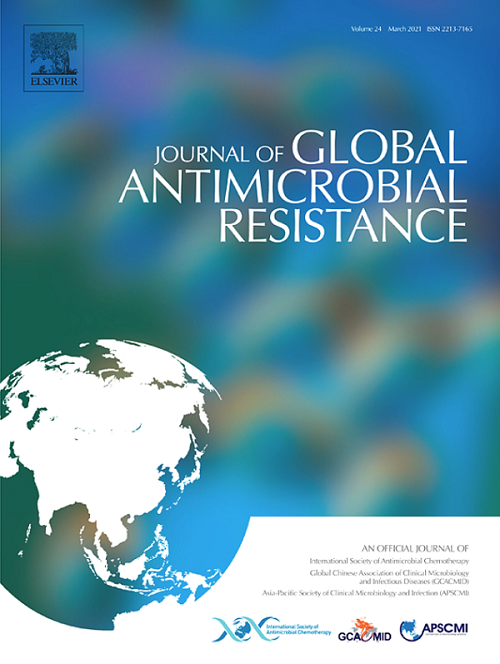Efficacy of high doses of intravenous fosfomycin for treatment of urinary tract infection caused by KPC carbapenemase-producing Klebsiella pneumoniae: An observational study
IF 3.7
3区 医学
Q2 INFECTIOUS DISEASES
引用次数: 0
Abstract
Objective
To evaluate the efficacy of high-dose intravenous fosfomycin for the treatment of urinary tract infections (UTI) caused by KPC carbapenemase-producing Klebsiella pneumoniae (KPC-Kp). A secondary objective was to evaluate the impact of the results of fosfomycin susceptibility testing on prognosis.
Methods
This is an observational and retrospective study. Patients hospitalized with UTI caused by KPC-Kp receiving treatment with high-dose intravenous fosfomycin were evaluated from December 2012 to June 2018. The primary outcome variable was clinical cure at d 21.
Results
Forty-seven patients were included. The results of commercial microdilution panels showed that KPC-Kp isolates from 14 (29.8%) and 33 (70.2%) patients were non-susceptible and susceptible to fosfomycin, respectively. In 28 available isolates, susceptibility was also determined by the reference agar dilution method. In the global cohort, clinical cure was achieved at d 21 for 33 (70.2%) out of the 47 patients, with no statistical differences found between fosfomycin non-susceptible isolates and fosfomycin susceptible isolates as determined by commercial microdilution (78.6 vs. 66.7%; P = 0.50) or by the reference agar dilution (83.3 vs. 72.7%; P = 1). In the logistic regression analysis, the Pitt index was the only variable related to clinical cure at 21 d. No statistically significant differences were found for the variables associated with fosfomycin susceptibility testing or fosfomycin minimum inhibitory concentration.
Conclusions
High-dose intravenous fosfomycin can be considered for treatment of hospitalized patients with KPC-Kp UTI in some scenarios. in vitro fosfomycin susceptibility testing for multiresistant KPC-Kp may be of limited clinical value.
大剂量静脉注射磷霉素治疗由产 KPC 碳青霉烯酶肺炎克雷伯菌引起的尿路感染的疗效。一项观察性研究。
目的:评价静脉注射大剂量磷霉素治疗产碳青霉烯酶肺炎克雷伯菌(KPC- kp)所致尿路感染的疗效。第二个目的是评估磷霉素药敏试验结果对预后的影响。方法:回顾性观察研究。对2012年12月至2018年6月接受大剂量静脉磷霉素治疗的KPC-Kp致尿路感染住院患者进行评估。主要结局变量为第21天的临床治愈。结果:纳入47例患者。商业微量稀释板结果显示,14例(29.8%)患者的KPC-Kp分离株对磷霉素不敏感,33例(70.2%)患者对磷霉素敏感。用对照琼脂稀释法测定了28株菌株的药敏性。在全球队列中,47例患者中有33例(70.2%)在第21天实现临床治愈,经商业微量稀释测定,磷霉素非敏感分离株和磷霉素敏感分离株之间没有统计学差异(78.6 vs 66.7%;P = 0.50)或参考琼脂稀释(83.3 vs. 72.7%; = 1页)。在logistic回归分析中,Pitt指数是唯一与21天临床治愈相关的变量。与磷霉素药敏试验或磷霉素MIC相关的变量无统计学差异。结论:在某些情况下,可考虑大剂量静脉注射磷霉素治疗住院KPC-Kp尿路感染。多耐药KPC-Kp体外磷霉素药敏试验临床应用价值有限。
本文章由计算机程序翻译,如有差异,请以英文原文为准。
求助全文
约1分钟内获得全文
求助全文
来源期刊

Journal of global antimicrobial resistance
INFECTIOUS DISEASES-PHARMACOLOGY & PHARMACY
CiteScore
8.70
自引率
2.20%
发文量
285
审稿时长
34 weeks
期刊介绍:
The Journal of Global Antimicrobial Resistance (JGAR) is a quarterly online journal run by an international Editorial Board that focuses on the global spread of antibiotic-resistant microbes.
JGAR is a dedicated journal for all professionals working in research, health care, the environment and animal infection control, aiming to track the resistance threat worldwide and provides a single voice devoted to antimicrobial resistance (AMR).
Featuring peer-reviewed and up to date research articles, reviews, short notes and hot topics JGAR covers the key topics related to antibacterial, antiviral, antifungal and antiparasitic resistance.
 求助内容:
求助内容: 应助结果提醒方式:
应助结果提醒方式:


